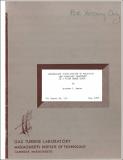| dc.contributor.author | Bates, Stephen Cuyler | en_US |
| dc.contributor.other | Massachusetts Institute of Technology. Gas Turbine Laboratory | en_US |
| dc.date.accessioned | 2016-09-27T19:59:03Z | |
| dc.date.available | 2016-09-27T19:59:03Z | |
| dc.date.issued | 1977 | en_US |
| dc.identifier.uri | http://hdl.handle.net/1721.1/104413 | |
| dc.description | June 1977 | en_US |
| dc.description | Originally presented as the author's thesis, (Sc. D.)--in the M.I.T. Dept. of Aeronautics and Astronautics, 1977 | en_US |
| dc.description | Includes bibliographical references (pages 123-124) | en_US |
| dc.description.abstract | The purpose of this work is to contribute to the fundamental understanding of fluid turbulence by visualizing its detailed flow structures. Examination of these coherent structures gives information about the turbulent flow that cannot be deduced from its statistics. This information should reduce the role of empiricism in the analysis of turbulence. The experimental method chosen is to visualize a turbulent plane free shear layer using stop-action photography of a phosphorescing trace gas. Choice of 1) direct photo-excitation, 2) collisional excitation, or 3) collisional de-excitation of the phosphorescencing gas with a planar light beam, permits identification of the emission with a cross-sectional map of the material from one stream that is 1) throughout the flow, 2) molecularly mixed with material from the other free stream (alone), or 3) molecularly unmixed. The plane shear layer visualized has been specified experimentally. Extant requirements for self-preservation are insufficient in general, and make the claim of self-preservation for the experimental flow only probable and not definite. A large data set using all three variations of the visualization technique show structures that imply a large amount of new information about turbulent mixing and turbulent processes. The data shows the structures to be simply connected, with slow variation out of the mean flow plane. Specifically, there is a simply connected region of mixed fluid that always separates material entering the layer from the free streams. Collisional excitation and quenching data strongly imply a turbulent mixing process of random bursting from the free stream, followed by internal viscous decay. The complementary process of turbulent entrainment is recorded in the quenching photos as nibbling of the free stream by the layer, together with a randomly occurring large local amplification of this nibbling, previously thought to be engulfment by the boundary. | en_US |
| dc.description.sponsorship | Research supported by Pratt & Whitney Aircraft Division, United Technologies Corporation (formerly United Aircraft Corporation) | en_US |
| dc.format.extent | 124 pages | en_US |
| dc.publisher | Cambridge, Mass. : Massachusetts Institute of Technology, Gas Turbine Laboratory, [1977] | en_US |
| dc.relation.ispartofseries | GTL report #134 | en_US |
| dc.subject.lcc | TJ778.M41 G24 no.134 | en_US |
| dc.subject.lcsh | Turbulence | en_US |
| dc.subject.lcsh | Flow visualization | en_US |
| dc.subject.lcsh | Collisional excitation | en_US |
| dc.subject.lcsh | Photography -- Scientific applications | en_US |
| dc.title | Luminescent visualization of molecular and turbulent transport in a plane shear layer | en_US |
| dc.type | Technical Report | en_US |
| dc.identifier.oclc | 04231956 | en_US |
